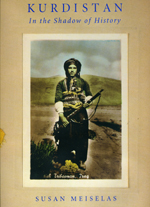Kurdistan—understanding the Middle East

Last Wednesday the New York Times’ Papercuts blog posted a short article on the Kurds and their important role in the complicated culture and politics of the Middle East. In the post, Papercuts contributor Barry Gewen cites several useful books on the subject including Susan Meiselas’ Kurdistan: In the Shadow of History, Second Edition. Gewen writes:
The hour of the Kurds has come round again. They are the great success story of the Iraq war, what the Bush administration always hoped for across the entire country. They have a functioning, popularly supported regional government. Their economy is booming. Religion has little retrograde or divisive influence on their public institutions. Women are respected (there have been many important female leaders in Kurdish history) and Israel is viewed approvingly. Terrorism is generally unknown in the Kurdish areas of Iraq. What’s more, the Kurds are ready to defend themselves and what they have achieved. Anyone who wants to understand the future of Iraq and the Middle East in general has to take them into account.
Two new books help us to do just that. Actually, one of them isn’t new. Kurdistan: In the Shadow of History by the photographer Susan Meiselas first appeared in 1998 and is now being reissued in an updated edition by the University of Chicago Press. It’s an extraordinarily handsome volume. In a labor of love, Meiselas spent six years combing libraries, archives and family collections for old photographs, postcards, documents, newspaper clippings, whatever, to produce a visually stunning montage designed to prick the conscience of the world.
Read the posting on the NYT‘s Papercuts blog.